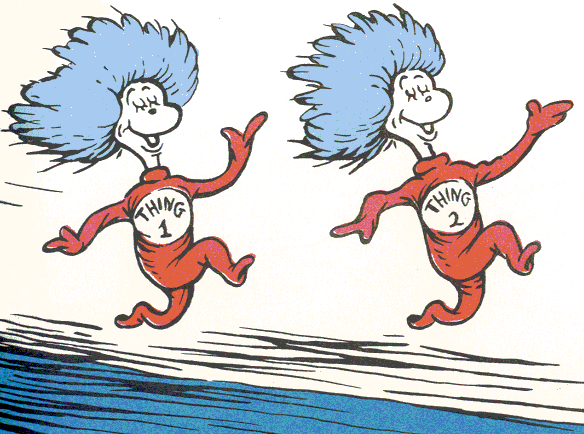So, once again, I’m starting off with a Twitter quote:
@barelyknit: Do I make myself finish just so I can say I did? Is that what #NaNoWriMo is about? ‘Cause I am NOT LOVING this novel.
@doycet: Pushing past the not-loving is one thing NaNoWriMo makes happen. The not loving thing happens every single time at some point.
@barelyknit: Good to know. This is my first larger project, so I’m not used to going on despite the apathy.
Now, I’m not posting this to pick on Jennifer. At all. She is not the only one thinking this.
People keep leaving comments (yay!) and twitter DMs (woot) about how I must be wired right into the NaNoWriMo GroupBrain, because I just seem to know exactly what’s about to happen to their nano project, day by day. Fact is, I’m just writing advice for whatever thing I happen to be having a problem with that day, because… surprise surprise… I am not a unique snowflake. None of us are. These problems are everyone’s problems, and if I have some insight into them, or Jennifer happens to mention out loud what lots of people are thinking, that is why.
I write about it cuz I’ve worked through these projects mumblety-times before. That’s it. I don’t always see it coming, but I always recognize it when it gets here, and I kinda-sorta remember how to deal with it.
Now then, bit of background: in my dayjob, I teach things to people – mostly, to adult people. That’s the simplified summary of it, anyway – it involves project management, and regular management, and online course development, and classroom course development, and a metric buttload of writing, as well as doing that actual thing that people think of when they think of ‘teaching’.
There’s a key thing to understand about learning: at some point, with anything that you’re learning how to do, you have to… you know… do it.
The first ugly fact about writing a full-length … well, anything … is that it’s a fuckton of work. The first draft isn’t even most of it; that’s like a decifuckton. A portion, is what I’m saying, but still a lot.
The second ugly fact about writing a full-length anything is that you don’t know if you can do it til you do it. That’s part of what NaNoWriMo is about — giving you a relatively fun way to determine if you can do it (and lots of company if you find out you can’t, yet).
The third ugly fact is that there is stuff you will NEVER learn about writing until you actually sit down and try to write the thing that you want to learn to write. That’s really the other thing that I think NaNoWriMo is good for… it let’s you take that final step in learning how to write a novel by writing a novel. In the end it’s the only damn thing you can do to really learn how, and one of problems that the process teaches you about is how to deal with not always liking your story.
So let’s talk about not liking your story.
This will actually happen a couple times per project, probably. If you’re lucky, you’ll just have one instance of it, but if so, it might go on a few days. There are (at least) Two Things you can do to deal with this. Note: these are not different options you select from — do both of these things.
Thing 1

So you’re not happy with the stuff going on right now? Sorry, but that’s tough. You’ve got a story to deliver, and sometimes you just have to soldier through.
Simple truth: some days, the words just come hard.1 2 Sometimes they’re hard because you’re not really loving the scene, or it’s just very tricky, or you suck at action sequences, or whatever.
This is one of those moments that defines. This is the thing that culls people from the herd before they get to the finish line, and there isn’t a better way to put it; if you want to finish your novel(la) length story, you learn to power through the days where you aren’t loving your work. Not the work – YOUR work, specifically.
If this seems like a NaNoWriMo thing, I have to tell you, it isn’t; this is a writing thing. NaNoWriMo may seem silly to some, but it does teach us – via the experience – to write long stuff, and this is one of the lessons: Sometimes, you gotta write anyway.
Thing 2
Try to leave out the part that readers tend to skip. – Elmore Leonard
Stop and ask yourself: “Why don’t I like what I’m writing? Why is this not working for me?” That’s an important question, because if the author doesn’t like it, who the hell else is going to?3
- Are you over-describing stuff? Stop. Switch to nothing but dialog for awhile. If you’re protag doesn’t have anyone to talk to, FIX THAT RIGHT NOW.
- Is the scene boring you? Drop it and skip to the next. Flag it with a [finish this later] and move on.
- Do you not care about the character? Get them in some conversations with other characters, so you can find something to like (or find out that you’re writing about the wrong person as the protagonist).
- Are you hung up on how to get through the current scene, but you’re writing a solution anyway? STOP. Go write some other scene — that reluctance is your brain telling you that you’re writing something stupid and that it will give you something not-stupid LATER.
- If all else fails, attack the scene with genre-appropriate ninjas. I am totally not kidding.
Bottom line: your lack of enthusiasm might be your brain telling you “Dude, I would skip this bit if it were in a book I was reading.” So skip it. If you need it, skip it and come back.
Let me give you an example.
Earlier this week, I was working on Adrift, and I got stuck. I’d written my characters into a bit of a corner, and I just… I didn’t know how to get them out of it. I wrote about 400 words that day, most of which involved the characters looking at each other, scratching their heads and saying “Well, fucked if *I* know.”
So I went and wrote something else. My main character (Finnras) is a dad, trying to find his daughter, so I went and wrote out one of the bedtime stories that he used to tell his daughter when she was a little girl and Everything Was Good. That was my writing for the next day, and it was good: one of those rare 3000+ days on word count.
And when I was done?
When I was done, the characters I’d left back in that nasty corner had figured a way out.
Thing #2 is a really good trick, by the way. I highly recommend keeping that particular tool handy.
So, to sum up:
You don’t like the story right now.
- Above all, keep writing.
- Find out what’s making you not like it, and either stop it, fix it, or leave it be and write a different bit.
That’s it. Get back to work.
Have fun.

1 – Actually, for me, the words rarely just fly onto the screen in mighty 5000 word clumps — it just doesn’t happen that often; maybe a half-dozen times in as many years. Maybe. I almost never get ‘ahead’ on my daily wordcount, because the daily deliverable is what gets my ass in the chair, and that habit is far more valuable than a 6000 word day. But I digress.)
2 – You totally thought I was going to make a ‘come hard’ joke, didn’t you? Perv.
3 – The answer to that is somewhat dependent on how many revisions the author has done. Finishing revisions sometimes leaves me with a very strong desire to never ever ever ever see that particular work again. Ever.


Thank you! Not only did you address the issue at hand, which is not liking what’s happening at the moment in this work, but you tackled another issue I have, which is – can I jump around?
I have many different files with different scenes, little blurby bits, and shit that I don’t even know what to call. I’m worried that in the end, I won’t even be able to assemble this thing without an engineer and a rodeo clown, but at least now I know I’m not the only one who has to move on to something else sometimes.
I’ve always been a linear writer, but I have found this year that jumping around suits me much better. I’m not familiar enough with the characters and world yet, I guess. And since it’s NaNo, I’m just gonna go with that and keep plodding along.